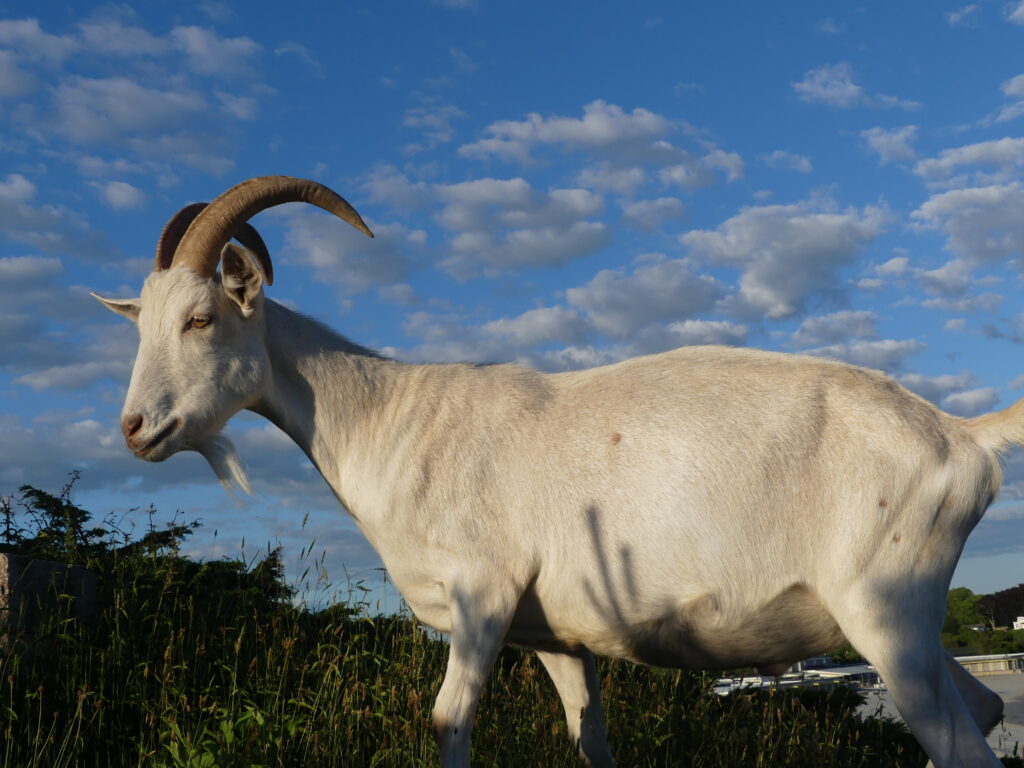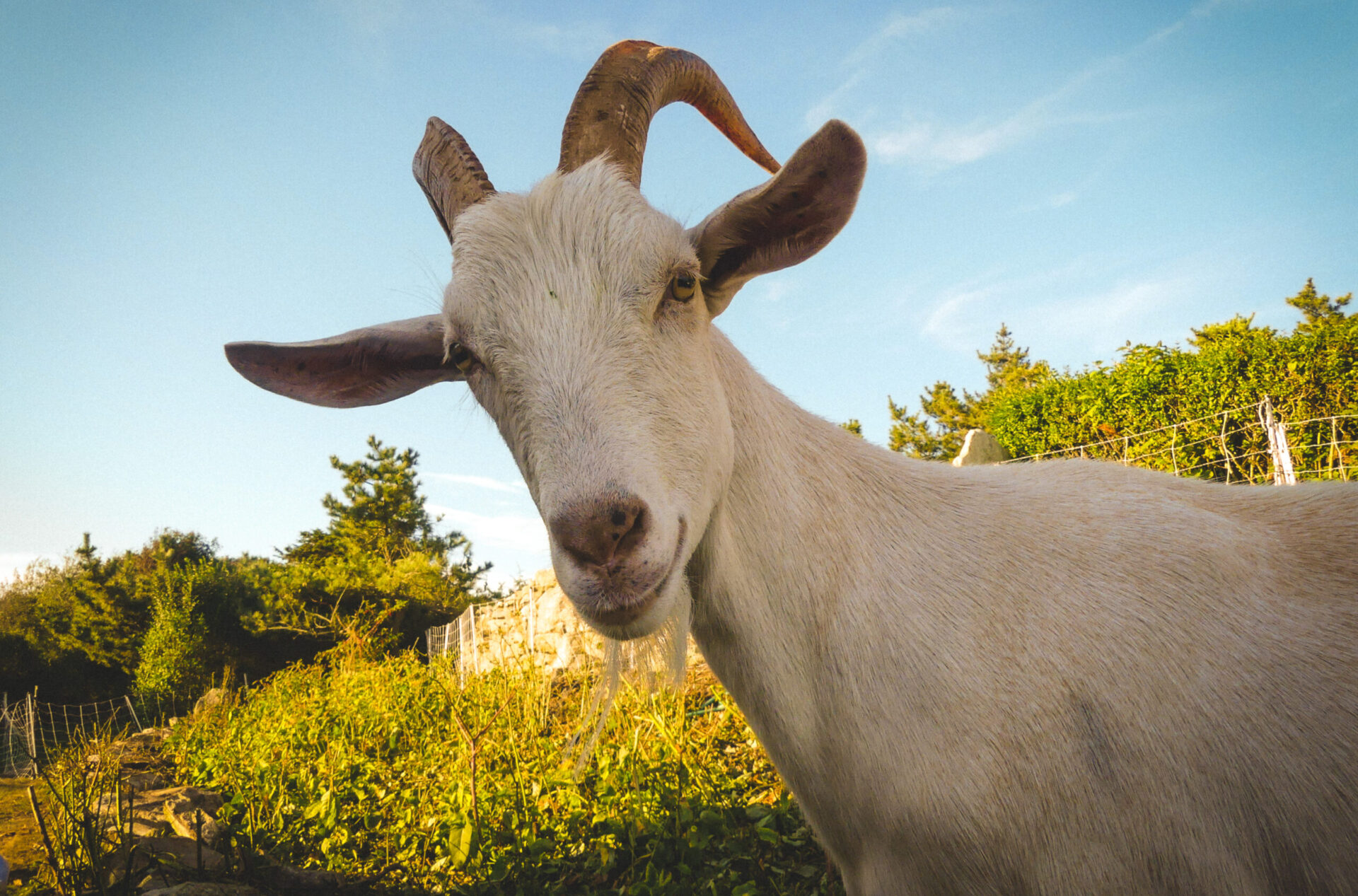Have you heard of goatscaping?
By Christopher Reeves
Clearing land, one bite at a time: Two teams of goats from the Sanctuary of Hope will eat their way through acres of noxious plants this summer
Photos courtesy Wayne Pitman
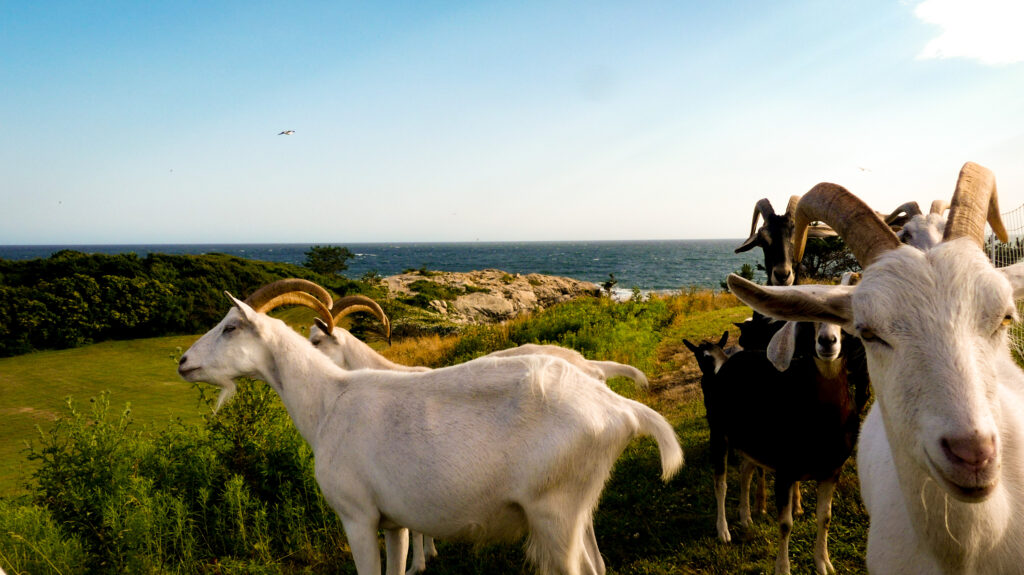
Wayne Pitman turns his bright red and green school bus down Lower Thames Street on a busy summer morning in Newport.
The bus marquee reads “Minnie’s Goat Coach”
Wayne slows the bus to a crawl to the delight of pedestrians craning to see the bus’s occupants, a small herd of 17 goats, codenamed Goat Team One. The gathering clamor of cameras and questions has caught the interest of the goats — who appear in the windows to watch the spectacle unfolding along the sidewalks. Their ambassador, a large gold goat named Sunny, balances on the stairs greeting tourists from the open door of the slow rolling bus.
Pitman and Goat Team One are on their way to a two-week landscaping job at a private property along Ocean Drive, where they will live together on Minnie’s Goat Coach and chew away overgrown plants. It’s a modern take on the ancient practice of using goats to clear land: goatscaping.
Goatscaping employs the goats’ natural behavior of browsing — eating vegetation from a height of about eight feet down to about six inches off the ground. It doesn’t involve fossil fuels or polluting herbicides and has lasting benefits that mechanical landscaping techniques do not.
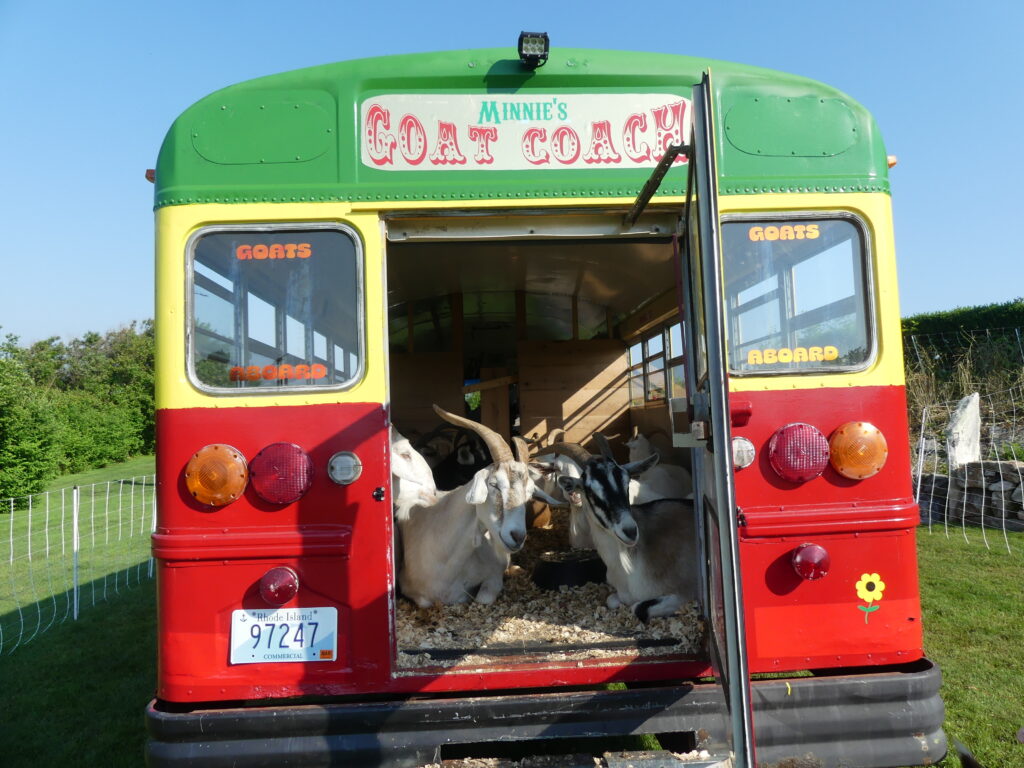
The goat advantage
Goats are especially great at removing invasive plant species, such as Bittersweet vines, which choke out native trees.
“Places that are impossible for people to get are where the goats shine — like the Portsmouth dog park,” says Pitman. “Nobody could walk into the woods because there was so much Bittersweet.
“We have a lot of customers who are trying to clear out a new space of land or are maintaining something that they don’t want to invade. Japanese Knotweed is a big one.”
Japanese Knotweed is an invasive plant worldwide that damages native ecosystems. One thesis published in the journal “Biological Invasions” concluded that no combination of soil removal, cutting, and herbicide cocktails completely eradicated the plant.
However, goatscaping appears just as effective at destroying Japanese Knotweed as intensive mechanical and herbicidal techniques combined.
Why do the goats beat the machines and chemicals?
Mowers, weed whackers, or heavy machinery dice vegetation, spreading seeds and small sections of stem back into the ground where they can grow anew — often making the problem worse. On the other hoof, goats naturally chew and ferment their food — their digestive system almost completely breaks down seeds, stems and leaves, rendering them harmless by the time they come out the other end as ready-made fertilizer.
Goats aerate the soil with their hooves as they walk, stomping their fresh fecal nutrients into the ground and enriching the soil as they go. Clearing the habitat of invasive weeds in turn encourages the return of native plants and animals to use the land.
According to the Environmental Protection Agency, habitat loss is one of the main reasons for a decline in native pollinator species over the last several decades. The EPA is committed to creating and protecting habitat for pollinators such as bees, birds and butterflies to improve ecosystem health — and to ensure the sustainability and economic benefits of food systems that those pollinators support. Removing overgrown nuisance plants makes room for pollinator-friendly native plants to regrow and thrive. This is where the goats come in.
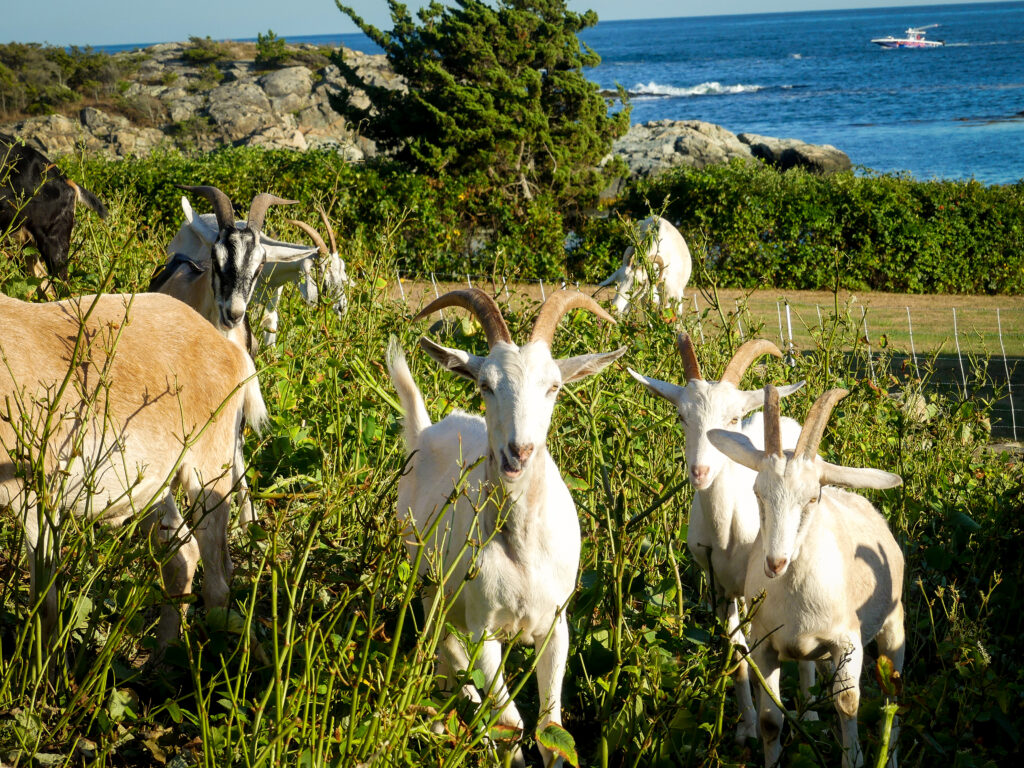
Eating on the job
Twice a year — each spring and fall — Pitman and Goat Team One can be found clearing the land around the EPA facility in Narragansett on the University of Rhode Island Bay Campus.
“The goats are absolutely effective at clearing dense brush on the hills and slopes that we can’t get into with equipment, and now it’s just the annual growth that the goats cut back,” says Adam Kopacsi, the facility’s operations and maintenance contracts project manager.
Kopacsi is responsible for creating pollinator habitat at the facility, and he says that native bees have returned to areas where goats have chomped and defecated away noxious, non-native plants. Kopacsi is quick to point out the additional benefits of using goats, such as the removal of poison ivy, reducing breeding habitat for ticks and opening previously inaccessible land to the public.
An added bonus: Visitors walking the EPA property are treated to the spectacle of the goats working (and living) alongside Wayne Pitman and their converted school bus.
“Early in the morning, I’ll come in, and you’ll see hooves sticking out the window where Wayne’s bunk is,” says Kopacsi.“They lay on top of him.”
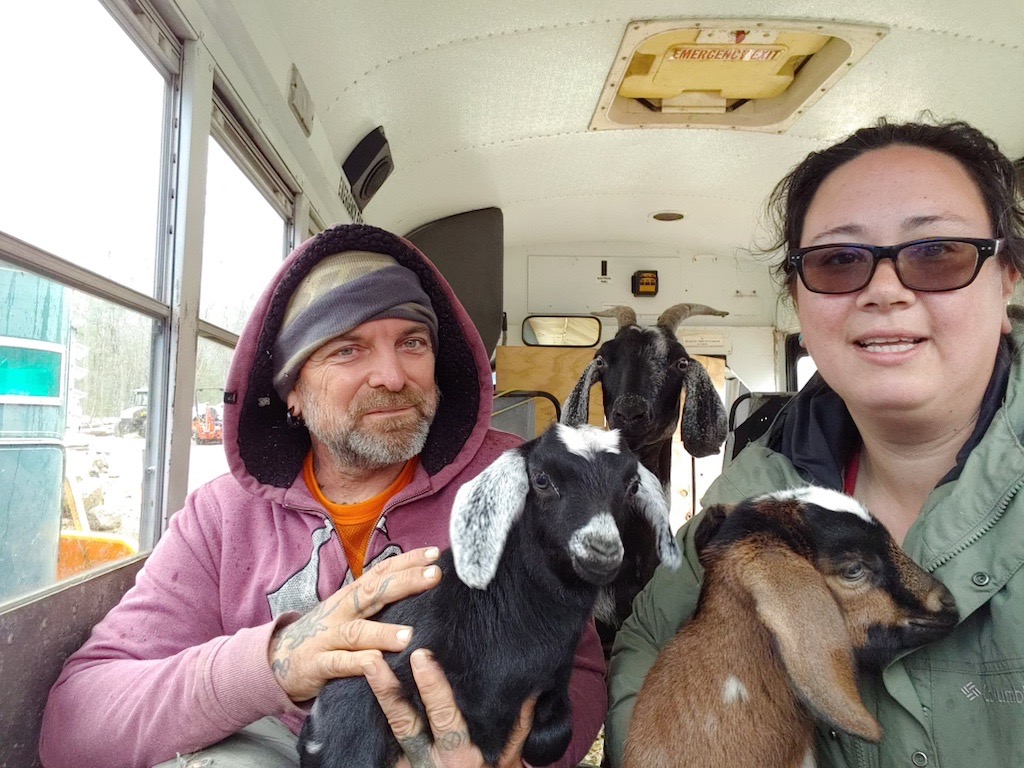
The Sanctuary of Hope
Pitman and his partner, Jackie Magnan, are co-owners of an animal sanctuary for their goat herd and a handful of other animals in Hope, Rhode Island, aptly named The Sanctuary of Hope.
The goatscaping operation is a practicality borne of their passions. “We’ll never kill or sell our goats for meat,” says Pitman. “We’ll never sell our goats — period,” chimes in Magnan.
Pitman is vegan, Magnan is vegetarian, and their goats will live a full life at the sanctuary after they retire from goatscaping service — settling into a sort of pastoral old goat’s home. It’s worth noting that humans have lived with domesticated goats for more than 10,000 years, often as nomads who earn a wage by selling goat products such as meat, milk or hides.
The couple started out with a few goats in their backyard. But when a buck they bought escaped and impregnated all the females, their herd doubled from 15 to 30 animals in one year. Caring for a herd that size comes with a hefty commitment in money and time. This led a veterinarian friend — who had read about goatscaping to create firebreaks in the Western United States — to suggest Pitman and Magnan create something similar in Rhode Island to raise money to care for their burgeoning herd of goats.
Through word of mouth, the herd was hired to clear the vegetation around the Harris Dam in Woonsocket, and the goatscaping operation was born.
This year, Goat Team One and Goat Team Two will nibble away noxious plants from May through October at a variety of private and commercial sites in Rhode Island, such as the EPA facility in Narragansett, The Ledges in Newport (where you may have seen the goats grazing in the distance each summer from Rejects or Bailey’s Beach) and FM Global, an insurance company whose property in Johnston includes 77 acres of wildlife habitat that doubles as a Certified Audubon Cooperative Sanctuary.
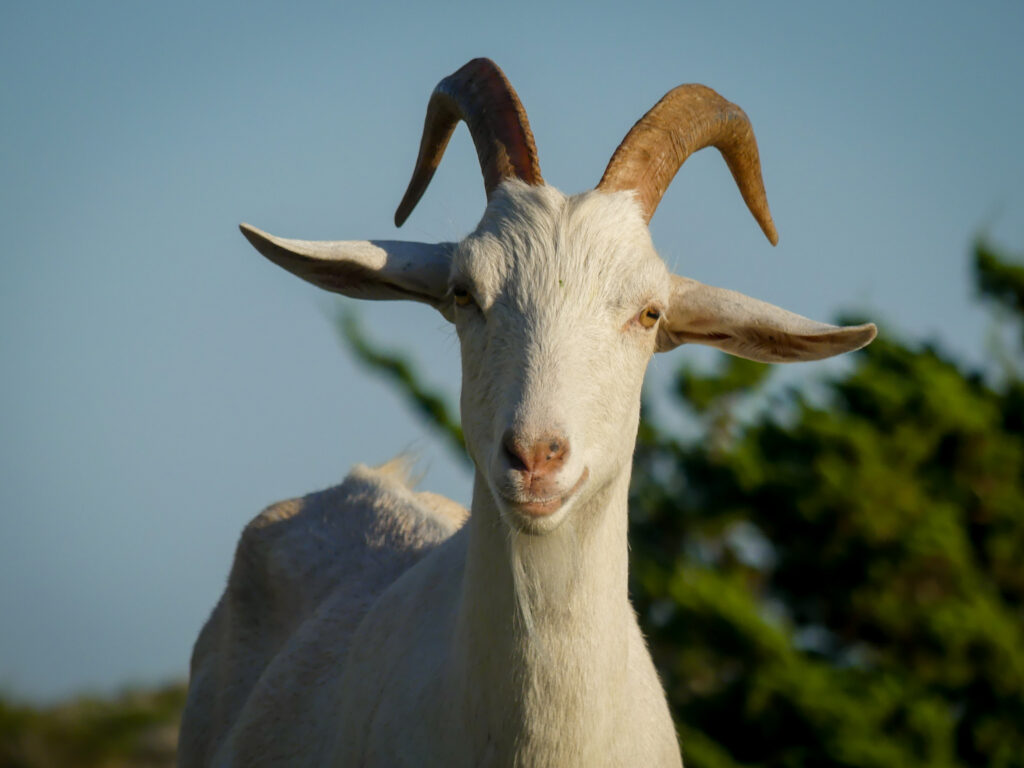
For the love of goats
Locals who had heard about Pitman and Magnan’s goatscaping operation began contacting them looking to find a new home for goats they had bought as backyard pets. For many people, goats are too much to handle.
“I’m not an unintelligent person, but I get tricked by the goats fairly frequently,” says Pitman. “All of our goats just needed a home.”
On a visit to The Sanctuary of Hope earlier this year, I was greeted by Voltaire, a regal goat with a shaggy mocha coat who sized me up with something like bemused mischief. He’s one of a group of three goats who escaped a local slaughterhouse on their own and found a home at the sanctuary.
Pitman and Magnan are busy strapping a spry-looking brown goat named Bullseye, who lost the use of his hind legs due to a spinal infection, into a specially built wheelchair. Bullseye appears unperturbed by the spinning tires as he scrambles around boulders and trees.
A handful of goats live on a short school bus whose marquee reads “Totes My Goats.” These goats have various medical conditions that require extensive, life-long care. Keeping farm animals for their full lifespan means growing ever-expanding veterinary expertise, especially as those animals become geriatric.
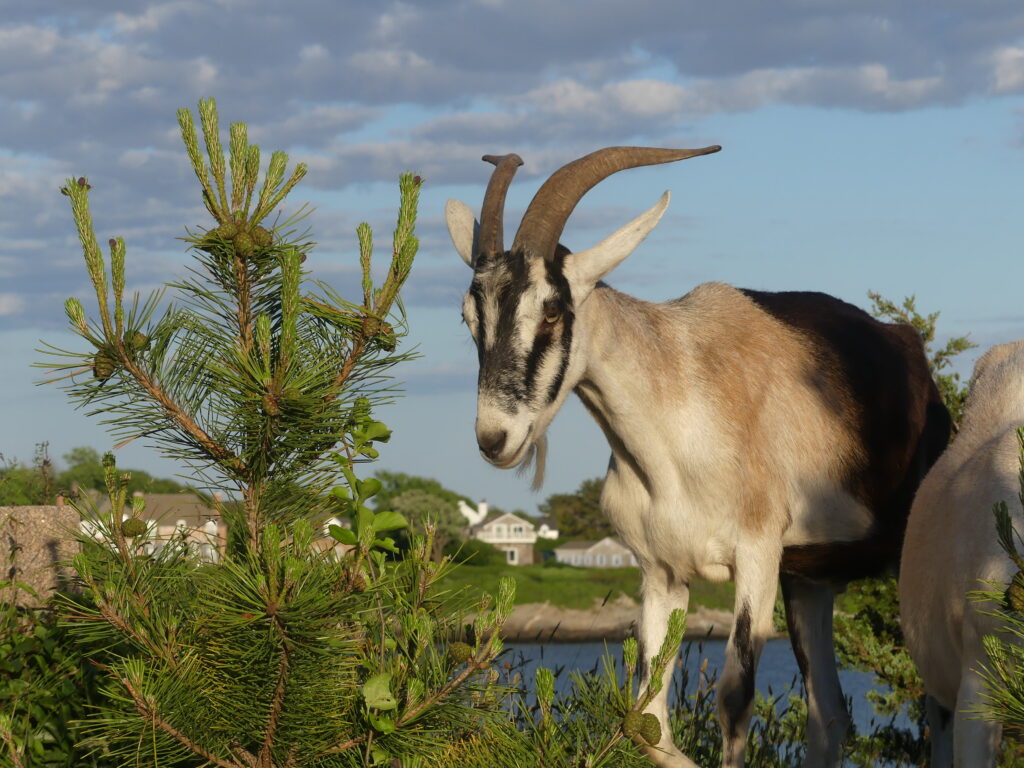
Prior to living with goats, Wayne Pitman was an aerospace engineer with a degree in Environmental Science — and ran a tattoo shop for over a decade. Jackie Magnan worked with horses on Philmont Boy Scout Ranch in New Mexico and is a Master Gardener and Plant Propagation Leader at the veggie greenhouse at the University of Rhode Island.
“They’re intelligent, well-educated, proactive people,” says Dr. Chris Hannafin, owner of New Shoreham Veterinary Services, and the friend who suggested goatscaping to the couple. “When there’s a medical condition, they need to know how to care for animals of different species. A lot of their knowledge was learned over the years through pursuing training and information on their own.”
Outside of providing services for The Sanctuary of Hope through his private veterinary practice, Hannafin is the director of the veterinary technology program at New England Institute of Technology, where he teaches livestock and large animal medicine. The Sanctuary of Hope is one of several farms that the program uses for instructing students.
In December 2022, The Sanctuary became an official 501(c)(3) nonprofit organization, and Hannafin now serves on the board of directors. Currently, goatscaping pays for roughly 70 percent of the sanctuary’s total needs. Pitman and Magnan hope that their new nonprofit status will increase their ability to cover the cost of animal care through donations.
This summer, the Sanctuary will host its first official fundraiser. Magnan says she hopes to build a bigger barn to use for education or animal therapy, and Pitman hopes to train a new herder, so he can eventually focus more on caring for the medical needs of the goats and other animals at their farm.
As for the coming season, the goatscaping teams expect to have full schedules.
Goat Team One will likely spend its entire summer between Newport, Jamestown and Little Compton, so watch for curious goats peering out the windows of their red and green bus-barns as they browse their way through unwanted weeds around Newport County.
Curiosity piqued?
The Sanctuary of Hope is looking for paid farmhands to help on the farm year-round — and a new goatherd. For more information on job opportunities, or to donate to The Sanctuary of Hope, contact Wayne Pitman or Jackie Magnan at www.thesanctuaryofhopeinc.com. And for lots of goat videos and educational content, check out Goatscaper/GoatTote Productions on YouTube.
